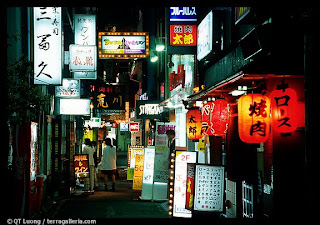
Pontochō (先斗町) is a district in Kyoto, Japan, known for geisha and home to many geisha houses and traditional tea houses. Like Gion, Pontochō is famous for the preservation of forms of traditional architecture and entertainment.


Geisha have existed in Pontochō since at least the 1500s, as have other forms of entertainment. Today the area, lit by traditional lanterns at night, contains a mix of very expensive restaurants—often featuring outdoor riverside dining on wooden patios—geisha houses and tea houses, and cheap eateries.

The area is also home to the Pontochō Kaburenjō Theatre at the Sanjo-dōri end of the street. This theatre functions as a practice hall for geisha and twice a year since the 1870s Kyoto geisha perform the Kamogawa Odori—Kamogawa river dancing, a combination of traditional dance, kabuki-like theatre, singing and the playing of traditional instruments—there, offering a rare chance for ordinary people to see performances by real geisha.

The name Pontochō is said to be a portmanteau of the English word "point" or the Portuguese word "ponto" (also meaning point) and the Japanese word meaning town, street, or road. The district crest is a stylized water plover or chidori.
Pontochō centres around one long, narrow, cobbled alley running from Shijo-dōri to Sanjo-dōri, one block west of the Kamo River (Kamogawa). This is also the traditional location of the start of kabuki, and a statue of Okuni still stands on the opposite side of the river.

Geisha have existed in Pontochō since at least the 1500s, as have other forms of entertainment. Today the area, lit by traditional lanterns at night, contains a mix of very expensive restaurants—often featuring outdoor riverside dining on wooden patios—geisha houses and tea houses, and cheap eateries.

The area is also home to the Pontochō Kaburenjō Theatre at the Sanjo-dōri end of the street. This theatre functions as a practice hall for geisha and twice a year since the 1870s Kyoto geisha perform the Kamogawa Odori—Kamogawa river dancing, a combination of traditional dance, kabuki-like theatre, singing and the playing of traditional instruments—there, offering a rare chance for ordinary people to see performances by real geisha.
Pontochō is also home to the tiny Tanuki ("Badger") Shrine. In 1978 a fire broke out in Pontochō, taking the life of a geisha. where it stopped, a ceramic tanuki was found shattered by the heat. Believing that Mr. Tanuki has sacrificed himself on their behalf, the residents built this little shrine to house his remains. Throw in a coin and record a message imparts such pearls of wisdom as "beware of fire."
Pontochō is also the location of the geisha house where American anthropologist Liza Dalby apprenticed.
No comments:
Post a Comment